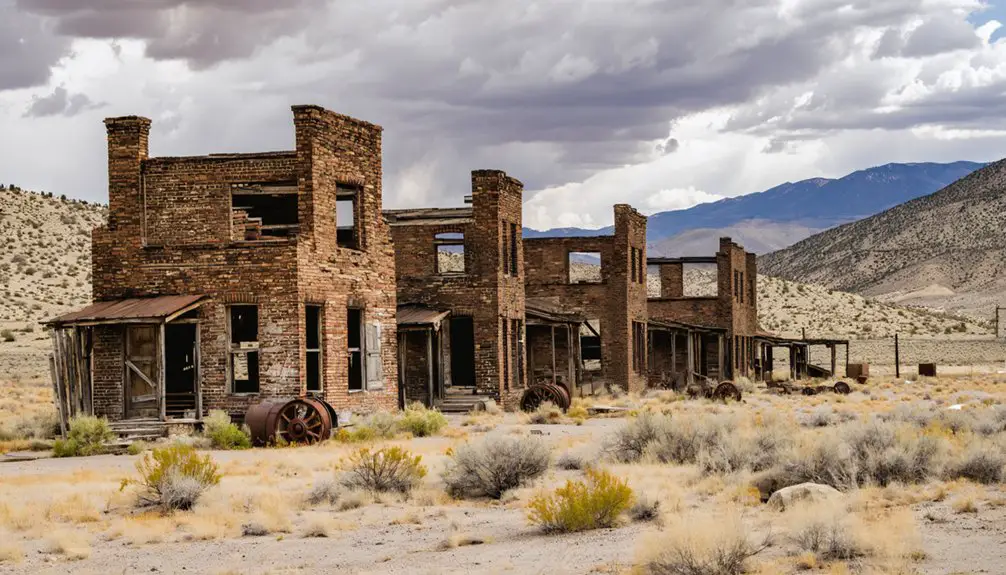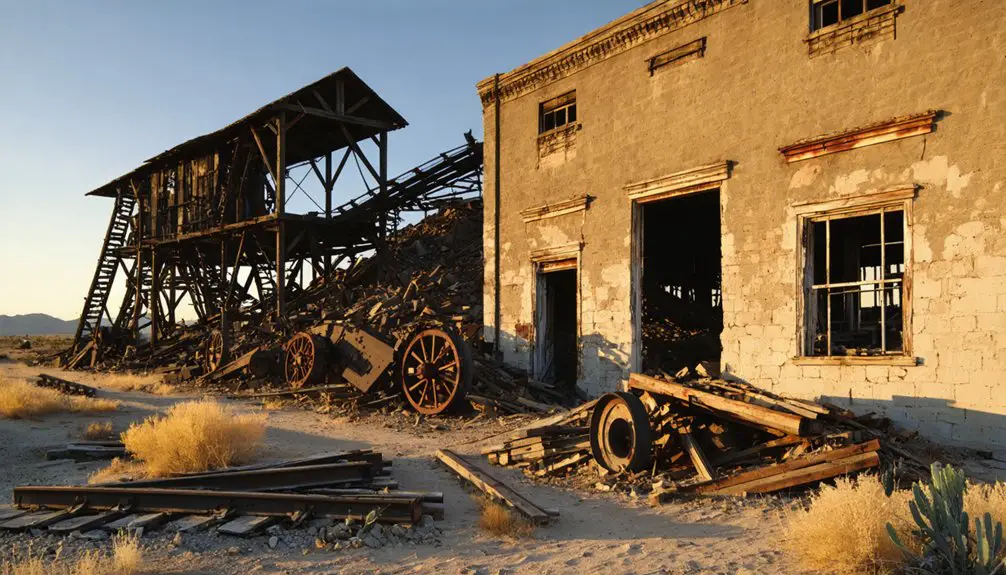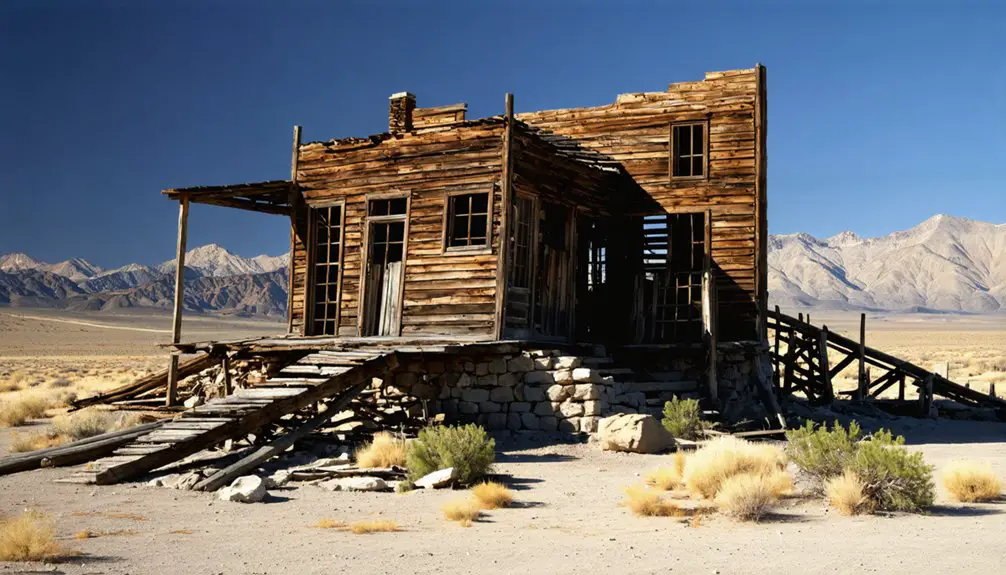Sutro, Nevada was a company town built around Adolph Sutro‘s ambitious four-mile tunnel project in the 1860s-1870s. You’ll find it nestled in Storey County, where it once supported the famous Comstock Lode silver mining operations. During its peak, nearly 900 residents enjoyed Victorian buildings, four parks, and a vibrant community life centered around the tunnel’s construction. Today, you can explore the first 50 feet of this engineering marvel and discover preserved structures that tell a remarkable tale of innovation and perseverance.
Key Takeaways
- Sutro was established in the 1860s as a mining town centered around the construction of the Sutro Tunnel, a revolutionary drainage system.
- The town reached its peak population of 800-900 residents during 1872-1878, featuring Victorian buildings, parks, and extensive community amenities.
- Adolph Sutro’s engineering marvel, a four-mile drainage tunnel, transformed mining safety and established the town as a model community.
- Population declined rapidly after 1880, dropping to 435 residents as mining profitability decreased and the tunnel’s limitations became apparent.
- Today, Sutro is preserved as a historic site with original structures, offering guided tunnel tours and grounds exploration to visitors.
The Birth of a Mining Marvel
While the Comstock Lode promised immense silver riches in 1860s Nevada, early mining efforts faced devastating setbacks that threatened the entire operation.
Early mining in Nevada’s Comstock Lode revealed the harsh reality behind silver dreams: massive obstacles threatened to derail fortune-seekers.
You’ll find that miners initially sought gold but instead encountered a peculiar bluish slush laden with silver, marking just the beginning of their mining challenges.
As shafts plunged deeper to 1,500 feet, scalding water at 110°F and toxic gases created life-threatening conditions.
The community’s resilience emerged through Adolph Sutro‘s visionary solution in 1860 – a four-mile tunnel through Mt. Davidson.
Despite skepticism and resistance from mining monopolies, Sutro secured legislative approval in 1865 and tirelessly raised funds across two continents.
His ambitious plan promised not just drainage and ventilation but also efficient ore transport to Carson River’s smelting facilities.
After facing early skepticism and mockery from the mining community about the tunnel’s feasibility, Sutro’s determination would ultimately prove his critics wrong.
The tunnel’s remarkable success allowed it to drain up to four million gallons daily from the waterlogged mines.
Adolph Sutro’s Grand Vision
Although the Comstock’s mining challenges seemed insurmountable, Adolph Sutro envisioned far more than just a drainage tunnel – he saw an opportunity to reshape Nevada’s entire mining landscape.
Sutro’s ambitions directly challenged the Bank of California’s iron grip on mining operations. After gaining support from miners and unions in 1869, his vision gained crucial momentum. He designed a revolutionary mining infrastructure that would integrate drainage, ventilation, transportation, and ore processing into one unified system. The massive undertaking took nearly ten years to complete from groundbreaking to finish.
You can see his strategic genius in establishing the town of Sutro, where miners could live and commute through his tunnel.
- Feel the bold defiance as Sutro stood against powerful banking interests
- Experience the pioneering spirit of a man who dared to reimagine mining’s future
- Witness how one visionary fought to free miners from corporate control
Engineering Feats of the Sutro Tunnel
You’ll find the Sutro Tunnel’s design remarkable for its era, measuring 10 feet wide by 12 feet high and extending nearly four miles to connect multiple Comstock Lode mine shafts.
The tunnel’s innovative gravity-based drainage system eliminated expensive pumping operations while providing essential ventilation and emergency escape routes for miners. Adolph Sutro initiated the project after deadly mine fires demonstrated the urgent need for improved safety. Today, visitors can explore the first 50 feet accessible during guided historical tours.
This pioneering engineering achievement, completed in 1878 after nearly a decade of challenging construction through hard rock, set new standards for mining infrastructure and safety across the United States.
Tunnel Design and Construction
As one of the most ambitious mining engineering projects of the 19th century, the Sutro Tunnel showcased remarkable design and construction features that revolutionized mining operations in Nevada’s Comstock Lode. The Friends of Sutro Tunnel continue preservation efforts to maintain this historic engineering achievement.
You’ll find tunnel efficiency maximized through its 10-foot width and 12-foot height, allowing ideal water drainage and ventilation across its 3.88-mile span. This mining innovation eliminated costly pumping while providing safer passage for miners. The visionary project, initiated by Adolph Sutro, transformed mining practices and worker safety conditions.
- You can trace the tunnel’s revolutionary construction from 1869 to 1878, as workers progressed from basic hand tools to advanced drilling equipment.
- You’ll marvel at how the near-horizontal design masterfully intersected multiple vertical mine shafts.
- You’re witnessing engineering history in the tunnel’s ability to serve multiple purposes – drainage, ventilation, and transportation – all in one structure.
Drainage System Innovation
The Sutro Tunnel‘s most revolutionary achievement lay in its groundbreaking drainage system, which transformed mining operations throughout Nevada’s Comstock Lode.
You’ll find that this engineering marvel redirected over 4 million gallons of scalding geothermal water daily, using advanced drainage technology that relied on gravity rather than expensive pumps.
The tunnel’s water management system incorporated wooden flumes that later evolved into metal pipes, stretching across its 3.88-mile length.
What made this innovation particularly remarkable was its passive drainage design – the carefully calculated grade allowed water to flow naturally from the depths to an outlet near Dayton.
This ingenuity didn’t just solve the flooding problem; it greatly reduced operational costs and created a sustainable solution that would influence mining operations for generations to come. The implementation of steam-powered machinery at key points along the tunnel system further exemplified Nevada’s commitment to engineering advancement. Under the visionary leadership of Adolph Sutro, the tunnel successfully achieved full mine connectivity by mid-1879.
Workers and Mining Safety
Mining conditions in Nevada’s Comstock Lode presented life-threatening challenges before the Sutro Tunnel’s construction, with workers battling knee-deep flooding, toxic gases, and stagnant air in confined underground spaces.
You’ll find that Adolph Sutro’s engineering solutions revolutionized worker safety through innovative ventilation and drainage systems. The tunnel’s design provided miners with safer access to deep ore deposits while reducing exposure to mining hazards.
- Imagine descending into dark, flooded mine shafts daily, knowing each breath could be filled with toxic gas.
- Picture the relief of thousands of workers when the tunnel’s ventilation system finally delivered fresh air underground.
- Consider how this engineering marvel saved countless lives by eliminating deadly working conditions that had plagued miners for years.
The tunnel’s completion set new standards for mining safety, influencing operations worldwide.
Life in a Company Town

If you’d lived in Sutro during its heyday, you would’ve found yourself in a carefully planned company town where the Sutro Tunnel Company controlled most aspects of daily life.
You’d have access to company-provided housing and essential amenities, including four eleven-acre parks, a hospital, school, church, and post office.
The town’s infrastructure and social fabric were meticulously designed around Adolph Sutro’s vision of a “model city,” featuring a wide main street that aligned with the tunnel portal and Victorian-style buildings that housed both workers and management.
Worker Housing and Amenities
Life in Sutro revolved around its carefully planned company infrastructure, where workers enjoyed amenities rarely found in other mining settlements of the era.
You’d find residential structures ranging from modest worker housing to elegant Victorian mansions, supporting a bustling population of 600-800 residents during peak construction.
The town’s thoughtful design included worker amenities like a post office, school, church, and hospital, while four eleven-acre parks provided space for recreation.
- Imagine strolling down the 200-foot-wide main street, shaded by trees watered from tunnel drainage.
- Picture yourself reading the latest news in the Sutro Independent, the town’s own weekly newspaper.
- Envision commuting through the tunnel to Virginia City for weekend dances and social gatherings.
Community Leadership and Control
While many Western mining settlements emerged organically, Sutro operated as a carefully controlled company town under Adolph Sutro’s ambitious vision. Through his tunnel company’s ownership of land, buildings, and essential services, Sutro exercised thorough community governance over residents’ daily lives.
You’d find corporate influence in every aspect of town life – from the company-run newspaper shaping public discourse to the carefully planned layout with its wide main street and irrigated trees.
The tunnel company controlled recreational facilities, organized social events, and provided critical services like healthcare and education. Even your social activities might’ve included company-facilitated dances in Virginia City, accessed through the tunnel.
This tight corporate oversight guaranteed an orderly community structure, though it left little room for independent development outside company control.
The Town’s Golden Age: 1872-1878
The six-year period between 1872 and 1878 marked Sutro’s most prosperous era, as this Nevada boomtown swelled to nearly 900 residents.
During this golden era, you’d have found a thriving community with four sprawling parks, tree-lined streets, and a bustling 200-foot-wide main thoroughfare.
The town’s community dynamics centered around the ambitious tunnel project, where over 1,000 workers labored while their families built lives above ground.
- You could’ve witnessed the weekly printing of the Sutro Independent newspaper, keeping residents informed of local happenings
- You’d have seen workers’ children attending the local school while their parents shaped the town’s destiny
- You might’ve caught a glimpse of President Grant visiting Sutro’s Victorian mansion during this peak period
Architecture and Urban Planning

Architectural grandeur defined Sutro’s physical landscape during its heyday, with the town’s most impressive structure being the Sutro Tunnel portal.
You’ll find this portal underwent three distinct transformations, from a simple opening to an ornate Greek Revival façade, and finally a Spanish-style design with practical metal doors for mining operations.
The town’s urban infrastructure supported up to 800 residents, featuring Adolph Sutro’s impressive three-story mansion equipped with gas lighting and indoor plumbing.
The architectural evolution extended beyond residential structures to include essential facilities like the mule barn, church, post office, and mine administration buildings.
Every structure served a purpose in this carefully planned mining community, where even the Sutro Pond played a dual role in supporting both mining operations and local water needs.
Social Life and Community Spirit
During Sutro’s peak years in the 1870s, you’d find residents enjoying four eleven-acre parks and attending community events that revolved around the mining schedules and church calendar.
You’d see families gathering at these parks, which were irrigated by tunnel drainage and provided welcome relief from the industrial nature of the mining town.
On Saturdays, you’d join other townspeople traveling through the tunnel to Virginia City for dances and social gatherings, demonstrating how the community maintained strong social connections despite their relative isolation.
Parks and Recreation Activities
Located within a sprawling 28-acre historic site, Sutro’s recreational offerings blend natural beauty with mining heritage through a variety of outdoor activities and guided experiences.
You’ll find well-maintained dirt roads and walking trails that lead you through historic structures and up to the hilltop mansion site. The serene Sutro Pond, once a source of frogs for local restaurants, now serves as a peaceful spot for wildlife watching and contemplation.
- Explore the first 50 feet of the preserved Comstock-era tunnel with knowledgeable docents
- Discover native aspens, willows, and abundant wildlife while picnicking near the historic pond
- Join guided tours that bring the ghost town’s rich mining heritage to life
The recreational spaces accommodate both individual explorers and groups, with rustic benches offering scenic views of the Carson River valley.
Community Events and Gatherings
Despite its eventual fate as a ghost town, Sutro once buzzed with vibrant community life centered around the town’s mining operations and social gatherings.
You’ll find records of grand community celebrations, like the 1869 Sutro Tunnel groundbreaking, complete with parades, brass bands, and feasts of spit-roasted beef. Saturday dances in Virginia City gave residents social connections beyond the tunnels.
Today, volunteer efforts by the Friends of Sutro Tunnel keep the town’s spirit alive through restoration work and educational tours.
You can join these preservation activities, walking through reopened tunnel sections and exploring remnants of gathering spots that once included four eleven-acre parks, a post office, and a historic bar.
Regular tours and special events continue to draw history enthusiasts together, maintaining Sutro’s legacy as a place of community connection.
Church and School Life
The social fabric of Sutro extended well beyond its mining operations through two foundational institutions: the town church and schoolhouse.
These pillars of community life served the 600-800 residents, offering structure and stability in the rugged mining environment. Church events provided spiritual guidance and social connection, while school programs equipped children with essential frontier education and life skills.
- You’ll find echoes of resilient community spirit in how these institutions fostered mutual support during mining accidents and hardships.
- Experience the legacy of educational outreach through modern-day Sutro Tunnel tours, connecting past to present.
- Discover how Saturday gatherings and holiday observances brought light to the challenging lives of mining families.
These cornerstones of Sutro’s social framework created an enduring sense of belonging that transcended the harsh realities of frontier life.
The Great Decline
While Sutro’s ambitious tunnel project marked a pinnacle of mining innovation, the town’s decline began shortly after its 1878 completion.
You’ll find that the population dropped from 600-800 residents in 1876 to just 435 by 1880, as economic challenges forced miners and businesses to relocate.
The tunnel’s inability to serve mines below 1,600 feet severely limited its usefulness, and declining mining profitability accelerated the town’s downfall.
Preservation and Historical Legacy

Since its transfer to the Friends of Sutro Tunnel in 2021, preservation efforts have transformed this once-abandoned mining site into an accessible historical treasure.
You’ll find meticulously restored structures using historically accurate techniques, while preservation challenges are tackled through careful allocation of resources. The site’s historical significance lives on through guided tours, where you can explore the first 50 feet of the tunnel and examine original mining equipment.
- Experience authentic 1860s square-set timbering techniques that showcase pioneer engineering ingenuity
- Walk the same paths as the miners who shaped Nevada’s destiny
- Connect with volunteer opportunities to become part of this living history
Today’s preservation work, led by dedicated volunteers and funded by private donations, guarantees Adolph Sutro’s remarkable engineering legacy will inspire future generations while honoring Nevada’s rich mining heritage.
What Remains Today
Standing sentinel at the base of the Comstock Lode, several original structures from Sutro’s mining heyday remain on the 28-acre site.
You’ll find wooden mule barns, a large warehouse building, and the iconic tunnel portal itself, each telling stories of the town’s bustling past.
Since 2016, the Friends of Sutro Tunnel have led restoration efforts to preserve these remaining structures.
While you can explore the grounds and take guided tours, many buildings still await repair.
The warehouse, once used for storing mining supplies and later converted to a dance hall, stands alongside German Cottonwood trees that line the historic streets.
Though the tunnel’s interior remains largely off-limits for safety, you can walk the grounds where miners once transported ore and supplies through this engineering marvel.
Frequently Asked Questions
What Happened to the Artifacts and Machinery Left Behind in Sutro?
You’ll find many artifacts preserved in museums and on-site, with ongoing machinery restoration efforts. Some items were lost to fires and decay, but volunteers actively maintain what’s left for public viewing.
Were There Any Notable Crimes or Lawlessness in Sutro’s History?
You won’t find records of major crime incidents or significant law enforcement issues. Instead, the area’s darker history centers on tragic suicides in the forest and accidental mining-related deaths.
Did Any Famous People Besides President Grant Visit Sutro?
You’d think a town of such historical significance would’ve drawn countless famous visitors, but besides President Grant’s well-documented visit, there’s no clear evidence of other celebrity appearances in Sutro’s records.
What Was the Average Wage of a Tunnel Worker in Sutro?
While exact tunnel wages aren’t documented, you’d find Sutro labor paid well in gold pieces, likely higher than average due to dangerous conditions requiring 15-minute work shifts in extreme heat.
Did Native Americans Have Any Significant Interactions With the Sutro Community?
You won’t find evidence of significant Native traditions or cultural exchange at Sutro. Historical records show minimal interaction between Native Americans and the mining town’s residents during its operational years.
References
- https://www.nvexpeditions.com/lyon/sutro.php
- https://westernmininghistory.com/towns/nevada/sutro/
- https://savingplaces.org/stories/safer-passage-inside-the-reopening-of-a-nevada-tunnel-that-protected-silver-miners-from-floodwaters
- https://forgottennevada.org/sites/sutro.html
- https://nvtami.com/2022/06/09/sutro-ghost-town-renaissance/
- https://www.jmaw.org/sutro-comstock-jewish-nevada/
- https://www.youtube.com/watch?v=fgMSaEokO0c
- https://nevadamagazine.com/issue/winter-2022-2023/21010/
- https://nvtami.com/2022/01/25/sutro-tunnel-portal-through-time/
- https://www.immigrantentrepreneurship.org/entries/adolph-sutro/



